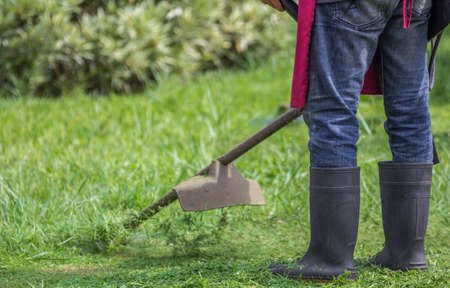Introduction to Modern Lawn Mowing in the UK
British gardening has long been celebrated for its lush lawns and meticulously maintained green spaces, reflecting a deep-rooted cultural appreciation for outdoor beauty and community pride. Traditionally, lawn care across the UK has centred on regular mowing, careful edging, and a commitment to aesthetic perfection, often achieved using petrol-driven mowers and chemical-based treatments. However, as environmental awareness grows and the impacts of climate change become increasingly evident, there is a notable shift towards more sustainable practices within British gardening. Homeowners, landscapers, and local councils alike are re-evaluating their approach to lawn maintenance by embracing eco-friendly equipment, organic solutions, and innovative techniques that support biodiversity while preserving the quintessential charm of British gardens. This transition marks a significant evolution in how lawns are cared for across the country, setting the stage for a future where sustainability is at the heart of every gardening decision.
Environmental Impact of Conventional Lawn Mowing
Traditional lawn care practices, prevalent across the UK, have a significant ecological footprint. The widespread use of petrol-powered mowers and chemical treatments in British gardens raises substantial concerns regarding sustainability. This section analyses the environmental repercussions of these conventional methods, highlighting their implications for air quality, soil health, and local biodiversity.
Ecological Footprint of Petrol Mowers
Petrol mowers are still commonly used in the UK due to their reliability and power, but they come at an environmental cost. These machines emit greenhouse gases and particulate matter, contributing to air pollution and climate change. According to recent studies, a single petrol mower can emit as much pollution per hour as several cars combined. The table below outlines key pollutants associated with petrol mowing:
| Pollutant | Source | Impact on Environment |
|---|---|---|
| Carbon Monoxide (CO) | Petrol combustion | Reduces air quality, hazardous to health |
| Nitrogen Oxides (NOx) | Engine emissions | Contributes to smog and acid rain |
| Particulate Matter | Exhaust fumes | Respiratory issues, settles in soil/waterways |
Chemical Treatments: Fertilisers and Pesticides
The use of synthetic fertilisers and pesticides is another area of concern. These chemicals may boost lawn aesthetics temporarily but often result in long-term ecological degradation. Runoff from treated lawns can pollute local waterways, while persistent chemicals disrupt soil microbiota and harm beneficial insects such as bees and earthworms.
Biodiversity Loss and Soil Degradation
Chemical-heavy regimes create monocultures, reducing plant diversity and providing little habitat for wildlife. In turn, the resilience of British gardens against pests and diseases diminishes. Soil structure also suffers; repeated chemical applications weaken natural nutrient cycles and increase dependency on artificial inputs.
Towards Greener Alternatives
The environmental impacts outlined above underscore the need for a transition towards sustainable lawn care in British gardening. Embracing low-emission equipment and organic practices not only mitigates ecological harm but also aligns with the UKs growing commitment to climate action and biodiversity conservation.

3. Innovative and Eco-Friendly Mowing Technologies
The British gardening landscape is rapidly evolving, embracing a new generation of lawn mowing technologies that prioritise both environmental sustainability and user convenience. Among the most notable advancements are electric mowers, which have become increasingly popular as homeowners seek quieter, emission-free alternatives to traditional petrol-powered models. Electric mowers not only reduce noise pollution—a key consideration in densely populated British suburbs—but also contribute to lower carbon emissions, aligning with the UKs wider commitment to combat climate change.
Robotic lawn care solutions represent another significant leap forward in sustainable gardening practices. These autonomous devices are equipped with advanced sensors and programmable settings, enabling precise and efficient grass cutting while minimising energy consumption. Robotic mowers are especially well-suited to the unpredictable British weather, as many models can operate during light rain and navigate varying garden layouts, from small urban plots to larger country lawns. Their growing uptake across the UK reflects a shift towards low-maintenance gardening, freeing up valuable time for homeowners while ensuring consistent turf health.
The adoption of these innovative technologies is further supported by government initiatives and local councils promoting greener gardening practices. Many retailers now offer incentives or trade-in schemes for upgrading to eco-friendly equipment, making the transition more accessible to the average British gardener. Additionally, the integration of smart features—such as app-controlled scheduling and adaptive cutting patterns—ensures that modern mowing solutions can be tailored to individual garden needs, maximising efficiency while reducing waste.
4. Sustainable Lawn Care Practices for British Households
As British gardeners seek to embrace environmentally friendly approaches, adopting sustainable lawn care practices becomes essential. The unique British climate—characterised by moderate rainfall and temperate conditions—offers both challenges and opportunities for greener gardening. Below, we explore practical guidance tailored to the UK context, focusing on mowing habits, natural fertilisers, mulching, and alternative lawn solutions like clover lawns.
Mowing Habits for Sustainability
Frequent, low-cut mowing is traditional but often unsustainable. For a healthier and eco-friendlier lawn:
- Mow less frequently: Allowing grass to grow slightly longer (6–8 cm) promotes deeper roots and retains soil moisture.
- Use sharp blades: Clean cuts reduce plant stress and susceptibility to disease.
- Opt for manual or electric mowers: These produce fewer emissions compared to petrol-powered options—particularly effective given the smaller garden sizes common in UK homes.
Natural Fertilisers and Mulching
Chemical fertilisers can harm local wildlife and pollute waterways. Instead, British gardeners should consider:
- Compost application: Home compost provides slow-release nutrients suitable for the steady growth typical in the UK climate.
- Mulching with grass clippings: Leaving clippings on the lawn returns nitrogen to the soil and reduces waste.
Sustainable Lawn Inputs Comparison
| Input Type | Benefits | Sustainability Score* |
|---|---|---|
| Chemical Fertilisers | Quick results; easy application | Low |
| Home Compost | Nutrient-rich; improves soil structure; cost-effective | High |
| Grass Clipping Mulch | No added cost; recycles nutrients; reduces landfill waste | High |
*Sustainability Score based on environmental impact and resource efficiency in UK gardens.
Clover Lawns: A Resilient Alternative
Clover lawns are gaining popularity across Britain as a low-maintenance, drought-resistant alternative to traditional grass. White clover, in particular, thrives in British soils and naturally fixes nitrogen, reducing the need for external fertilisers. Benefits include:
- Drought tolerance—ideal for unpredictable British summers.
- No requirement for chemical inputs.
- Enhanced biodiversity—supports bees and other pollinators.
Clover vs Traditional Grass Lawns
| Lawn Type | Main Benefit | Main Consideration |
|---|---|---|
| Clover Lawn | Sustainable, supports wildlife | Different texture/appearance from standard turf |
| Traditional Grass Lawn | Classic look; tolerant of foot traffic | Higher maintenance; greater water/fertiliser needs |
By incorporating these sustainable practices—smart mowing, organic fertilisation, mulching, and exploring alternatives like clover—British households can create lawns that are not only attractive but also resilient, environmentally friendly, and perfectly suited to local conditions.
5. Community Initiatives and Changing Attitudes
The evolution of lawn mowing in Britain is not solely driven by technology and private choices; it is also shaped significantly by community initiatives and shifting public attitudes towards sustainability. Across the UK, local councils have launched a variety of programmes aimed at reducing the environmental impact of traditional gardening practices. These include schemes encouraging residents to reduce mowing frequency, plant wildflower meadows, and adopt more biodiversity-friendly approaches in communal green spaces.
Local Council Programmes
Many councils now support ‘No Mow May’ and similar campaigns, urging homeowners and public park managers to let grass grow longer during peak wildlife seasons. This not only benefits pollinators such as bees and butterflies but also helps improve soil health and water retention. Some authorities provide educational resources or even distribute native seeds to facilitate this transition, underscoring a commitment to greener, more sustainable communities.
Community Gardens: A Collaborative Approach
The resurgence of community gardens across British towns and cities exemplifies collective action towards sustainable gardening. These shared spaces often prioritise organic practices, composting, and habitat creation over manicured lawns. Community gardens offer practical demonstrations of eco-friendly mowing methods—such as using hand tools or electric mowers—and serve as hubs for knowledge exchange on permaculture, wild planting, and carbon reduction.
A Cultural Shift Towards Eco-Conscious Gardening
Underlying these developments is a broader cultural shift within British society. Gardeners increasingly recognise their role as stewards of the environment. There is growing appreciation for naturalistic landscapes that promote ecological health rather than mere aesthetic orderliness. This change in mindset is evident in the popularity of wildlife-friendly garden competitions, educational workshops on sustainable horticulture, and media coverage celebrating less formal garden styles. Collectively, these efforts are redefining what it means to maintain a ‘proper’ British lawn, with a clear emphasis on sustainability and community engagement.
6. The Future Outlook for Sustainable Gardening in Britain
The landscape of British gardening is on the cusp of a significant transformation as innovative solutions and heightened public awareness converge to redefine traditional lawn and garden care. In the coming years, it is expected that sustainable gardening will become increasingly mainstream, driven by both environmental necessity and consumer demand for greener alternatives.
Integration of Advanced Technologies
One of the most promising developments lies in the adoption of smart technologies. Robotic mowers powered by renewable energy sources, sensor-driven irrigation systems, and AI-assisted garden planning tools are set to revolutionise how British homeowners approach lawn maintenance. These innovations not only reduce carbon footprints but also optimise resource use, ensuring water and energy efficiency at every stage of garden care.
Changing Attitudes and Behaviours
As public awareness around biodiversity loss and climate change grows, there is a noticeable shift in attitudes towards traditional lawns. Britons are increasingly open to alternatives such as wildflower meadows, pollinator-friendly borders, and no-mow zones. This trend is likely to accelerate as educational campaigns and community initiatives highlight the ecological benefits of sustainable practices, fostering a culture where pristine lawns are no longer seen as the gold standard.
Policy Support and Local Engagement
Government policies and local council programmes will play a pivotal role in shaping this future. Incentives for adopting eco-friendly garden equipment, grants for community green spaces, and stricter regulations on chemical usage are anticipated to support widespread behavioural change. Collaboration between policymakers, industry leaders, and gardening enthusiasts will be crucial in establishing sustainable gardening as an integral aspect of British life.
A Greener Vision for Tomorrow’s Gardens
Looking ahead, the fusion of innovation and increased environmental consciousness promises a future where British gardens are not only aesthetically pleasing but also resilient ecosystems that contribute positively to local wildlife and community well-being. By embracing these changes today, the UK can lead by example—setting new standards for sustainable lawn care that align with national goals for carbon neutrality and environmental stewardship.


